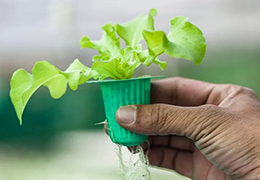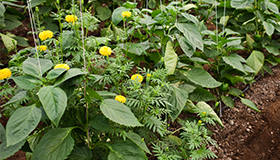How much water is my garden getting?
Ferry-Morse Home Gardening Blog | 2024

Watering a garden of purple flowers with a verdigris garden hose
According to the Environmental Protection Agency (EPA), the average American household uses 30 percent of its water outdoors—amounting to almost 8 billion gallons each day!
And during a hot summer, a single household’s outdoor water use can increase to 70 percent. It gets worse because about 50 percent of that outdoor water is wasted due to inefficient watering practices.
It doesn't have to be that way. You can have beautiful landscaping and be more responsible while supplying adequate water to support your growing plants. It only takes a few extra turns of the spigot to tighten up your water usage, and we can show you how!
This article will cover water use and management concepts to help you understand how to use your resources to support an attractive landscape while protecting the environment. Let’s take a closer look.
How much rain or water does my garden need?
So, here’s the deal. Garden irrigation supplements rainfall.
When soil moisture from rain supports healthy plant growth, watering plants is not needed. It makes complete sense, right?
However, in the absence of adequate rainfall, a properly designed and installed landscape requires about one inch of water per week.
Low, moderate, and heavy rainfall explained.
Generally, rainfall amounts are classified as follows:
- Low rainfall is 0–3 inches per month.
- Moderate rainfall is 3–6 inches per month.
- Heavy rainfall is 6–10+ inches per month.
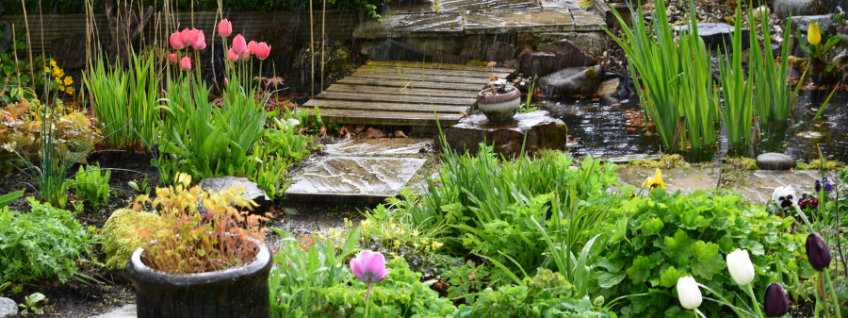
Spring rain falling on a garden of tulips and other plants
How much rainfall is my garden getting?
A simple way to measure rainfall is by using a rain gauge.
And check this out; there’s even a rainfall calculator that estimates the number of gallons of rain that can fall during a storm. Pretty cool, right?
Learn more about rainfall in your growing zone by checking out these national temperature and precipitation maps and the National Climate Report, available through the National Oceanic and Atmospheric Administration (NOAA).
The best part is that rainwater is a high-quality alternative to municipal water supplies. So, consider installing a rain barrel to collect rainwater for watering your garden. Let’s learn more.
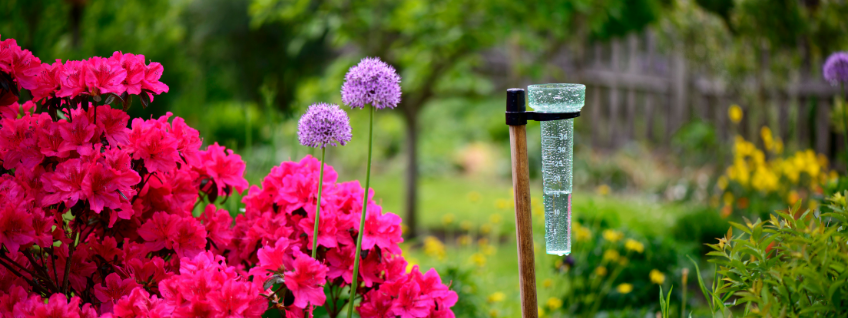
A rain gauge in a garden of pink and yellow flowers and purple allium blossoms
What are the different options for watering and irrigation?
Once you know how much rainfall you’re receiving, you can better understand the type of irrigation you’ll need for your landscape, which can range from simple to complex.
After all, garden irrigation systems exist to supplement the rainfall you receive in your growing zone. So, you’ll want to choose one that complements rainfall to reduce unnecessary water use. Let’s see what our options are.
Watering cans
Watering cans work great for indoor, outdoor, and container gardens. They’re simple, inexpensive, and help you get in a bit of exercise from walking while carrying water.
They deliver a gentle flow of water to plants that you can control, making it easier to water plants at their base away from leaves and closer to the roots.
When watering restrictions are in place due to drought, watering your garden with a watering can usually counts as an exception due to the low risk of water waste.
Garden hose
A garden hose is a common household item that provides a low-maintenance, low-waste way to water your garden. You can use a garden hose with or without a hose nozzle.
In many municipalities, hand watering with a hose is one of the few exceptions to watering restrictions. This method uses less water than other garden irrigation methods.
Check out this flow rate calculator to determine the volume of water you can deliver to your plants via a garden hose.
Soaker hoses
Soaker hoses consist of porous material through which water seeps out along the length of the hoses, soaking the soil.
Each hose supplies water at the base of plants making it readily available to plant roots while reducing water lost to evaporation. Soaker hoses work best in a
Sprinkler system
Sprinkler systems are the most common landscape irrigation method, ranging from portable hose-end sprinklers to underground systems. Some are manual, and some are automated.
They require routine checking and maintenance to prevent water waste and overwatering. Automated systems especially should have sensors to ensure water is applied when needed, such as in the absence of adequate rainfall.
Since they wet the above-ground parts of plants, prevent diseases by using sprinkler irrigation in the morning to allow plant foliage time to dry throughout the day.
When sprinkler systems aren’t maintained properly, or their usage isn’t monitored, they can be one of the most wasteful automated methods of irrigating your landscape. So, it’s best to hire a certified irrigation professional to design and install an automated sprinkler system.
Drip irrigation
Drip irrigation consists of flexible tubing perforated with tiny holes through which water flows out slowly (drips) at a uniform rate. It’s ideal for use in a mulched landscape.
The main benefits of this method are that it moistens plants’ root zones evenly, reduces evaporation, and does not wet leaves while watering your garden.
When installed and operating correctly, drip irrigation is usually the least wasteful automated type of irrigation. Many do-it-yourself (DIY) kits are available. Alternatively, hiring a certified professional can help you if you’re not comfortable installing a drip irrigation system yourself.
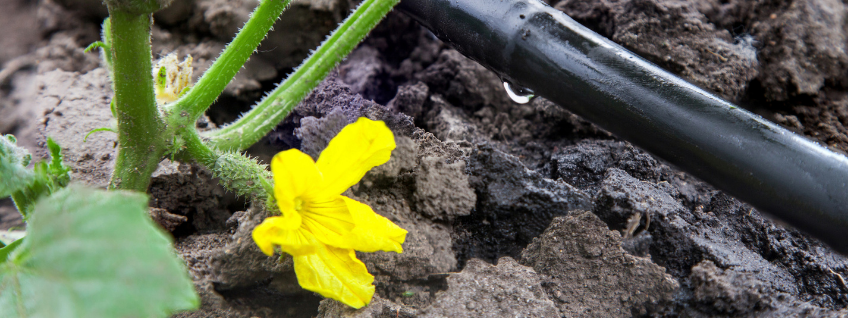
Drip irrigation tubing in a seedling garden bed next to a cucurbit blossom
When do plants need water most?
Plants need water most:
- During the first few weeks of development.
- Immediately after transplanting.
- While fruits and vegetables are developing.
In addition, seeds, young plants, and newly planted trees require moist soil until germination or roots establish.
Let’s review other gardening situations of when water is needed. Keep reading.
Potted plants
Only apply water to potted plants when the root zone dries out, located in the bottom two-thirds of the pot.
For many varieties, like peace lilies, basil, and peppers, you’ll know it’s time to water when their leaves droop slightly. Consider using a moisture meter to accurately determine when it’s time to water your potted plants.
Native and adapted varieties
Native and adapted varieties can usually get by on rainfall alone. When rain is above or below the normal average for your growing zone, you will need to adjust watering accordingly to support your growing plants.
Soil type
Light, sandy soils require more watering than heavy, clay, or dark soil textures.
Keep in mind that healthy soil is water efficient. It’s because organic matter from compost and other amendments improves drainage and nutrient availability in clay soil while slowing water loss in sandy soil.
Therefore, it’s essential to know your soil type and amend it accordingly. So, be sure to check out these instructions for determining your garden’s soil type.
Dormant perennials
Water dormant perennials in winter because their roots are still active.
In addition, dried-out roots probably won’t survive freezing temperatures. So, be sure to water the soil around your plants before a freeze.
The landscape rule of thirds
Simply put, the landscape rule of thirds involves dividing your landscape into thirds to include one section each for:
- Drought-tolerant turf grass
- Native and adapted plants
- Permeable hardscape
It’s an excellent guideline for installing a water conservation landscape that is visually appealing and maximizes your available space.
For inspiration, the Environmental Protection Agency (EPA) put together a What to Plant list of water-smart plants by state. Also, see their landscape photo gallery for ideas and inspiration. Trust us; these are genuinely actionable resources that are worth your time to check out.
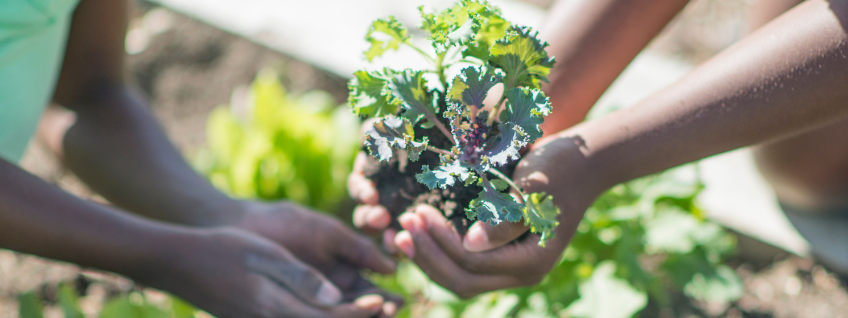
A mother handing a small brassica plant to her daughter to transplant into a garden
How do I handle drought conditions in my garden?
In a drought, hand watering with a watering can or garden hose is almost always acceptable, even if watering restrictions are in place.
Also, a drought is an awful time to make changes to your landscape. Try to hold off on installing new plants or transplanting existing ones until the drought ends or milder weather prevails.
In arid climates, sandy soil does a poor job of retaining water. So, slow the rate at which water drains out of the soil by amending it with compost.
Deep roots help plants survive low-water conditions. Encourage them by watering your garden deeply at less frequent intervals, ensuring water reaches a depth of about six inches in the soil.
Spend some time learning more about the soil type in your growing zone by checking out the United States General Soil Map provided by the United States Department of Agriculture (USDA).
Be proactive
If your growing zone is prone to drought, choose drought-resistant varieties to plant a water conservation garden suited for your region. It makes sense, right?
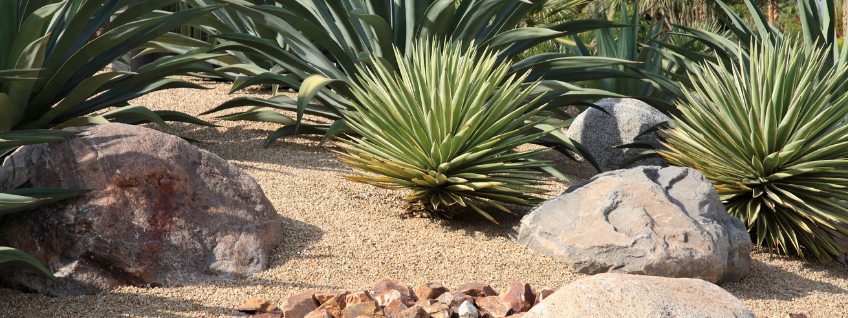
A drought-resistant landscape of succulents, accent rocks, and permeable hardscape
What should I do if my garden receives too much water?
Hyper-saturated soil forces air out, interfering with the ability of roots to take in water and nutrients, resulting in sad, smothered plants. And nobody wants that.
If you often notice pools of water around your plants that don’t drain away quickly, then consider transplanting them to a spot with better drainage. Try a drainage test to help you find the perfect place.
If watering your garden with a timed sprinkler or drip irrigation system, install sensors to prevent overwatering and other problems. For plants in containers, be sure to empty drip trays to prevent plants from sitting in water.
In wet climates, build raised beds six inches or higher and fill them with a balanced planting mixture that promotes aeration that includes perlite or vermiculite. Also, break up compacted soil.
Finally, if excess water is a continuing problem, think about redirecting it with a
Be proactive
Puddles and soggy spots in a garden are no good. Here’s how you can prevent them.
Proactively prevent overwatering by grouping plants of similar moisture needs together, a practice called hydro-zoning. Learn more about it!
And always make sure that water drains away from your garden. It’s pretty simple, right?

A flooded garden after heavy rain
When is the best time to water my garden?
During your growing season, the general rule of thumb is to water your garden before 10:00 a.m. and after 6:00 p.m. So, you might be wondering why we’ve listed an evening time here after we’ve gone on and on about watering early in the day.
Here’s the deal, watering early in the day is best for plants because it significantly lessens the risk of diseases. Just like water helps seeds germinate, it also allows fungi and bacteria to activate on plants’ foliage, which is why we strongly encourage early watering.
But, if you are using an irrigation method that doesn’t wet plant foliage—like soaker hoses or drip irrigation, then watering after 6:00 p.m. is fine.
Sometimes we have to water when we can, which is better than making our thirsty plants suffer, especially when the weather is super-hot outside! But don’t only take our word for it—learn more here.
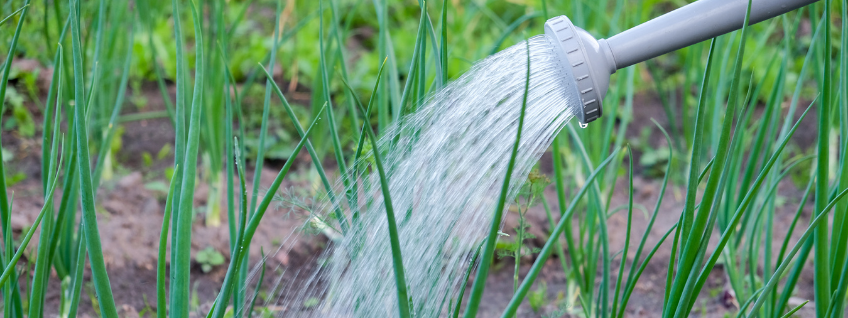
Watering onion plants in a garden with a watering can
A few last drops on garden irrigation
Although we all love our plants, the main thing to remember is not to love them so much that we overwater them, which is one of the leading causes of poor plant performance.
Besides, conserving our valuable water resources is good for the environment, and we all want to do that!
Here are a few sparkling drops to help you take the next steps in watering your landscape efficiently:
- Instead of having set days to water, apply water only when it’s needed.
- If runoff is a problem, try the cycle and soak method.
- After new plantings establish, decrease watering gradually to encourage deep root systems.
- Regularly check and maintain irrigation systems for leaks and consider performing a catch can test.
- Don’t set and forget automated irrigation systems—use rain and freeze sensors.
Our goal is to keep you afloat with the best information. So, please do not hesitate to contact us at any time for support. Happy watering!
CLICK HERE TO EXPLORE THE REST OF THE FERRY-MORSE GARDENING BLOG -->


